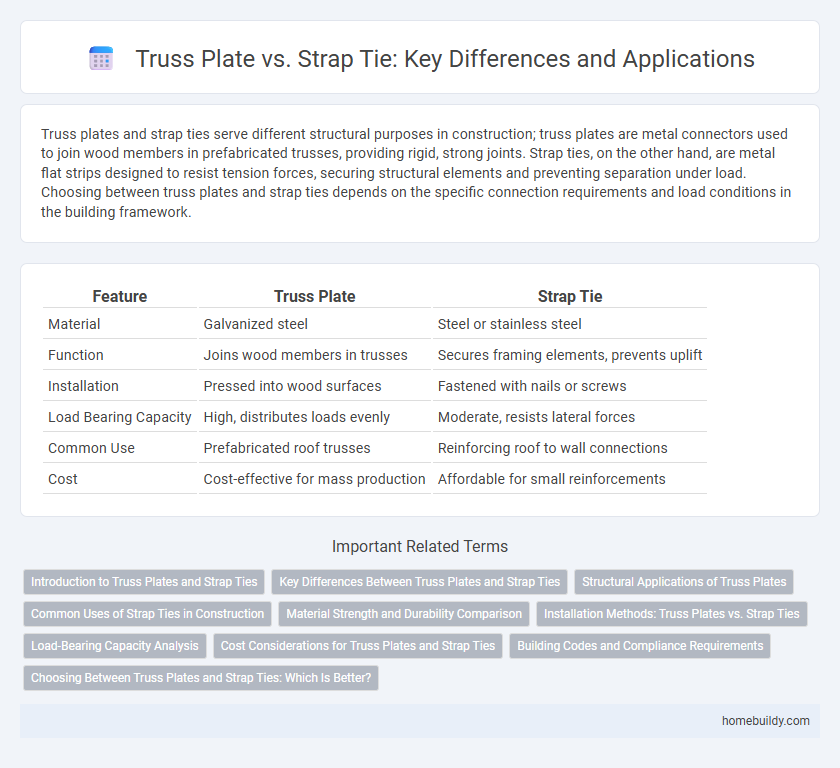Truss plates and strap ties serve different structural purposes in construction; truss plates are metal connectors used to join wood members in prefabricated trusses, providing rigid, strong joints. Strap ties, on the other hand, are metal flat strips designed to resist tension forces, securing structural elements and preventing separation under load. Choosing between truss plates and strap ties depends on the specific connection requirements and load conditions in the building framework.
Table of Comparison
| Feature | Truss Plate | Strap Tie |
|---|---|---|
| Material | Galvanized steel | Steel or stainless steel |
| Function | Joins wood members in trusses | Secures framing elements, prevents uplift |
| Installation | Pressed into wood surfaces | Fastened with nails or screws |
| Load Bearing Capacity | High, distributes loads evenly | Moderate, resists lateral forces |
| Common Use | Prefabricated roof trusses | Reinforcing roof to wall connections |
| Cost | Cost-effective for mass production | Affordable for small reinforcements |
Introduction to Truss Plates and Strap Ties
Truss plates are metal connectors used to join wood members in roof and floor trusses, providing structural stability by distributing loads evenly. Strap ties are flat, elongated metal connectors that reinforce wood joints, preventing lateral movement and offering additional resistance against uplift and shear forces. Understanding the differences in design and function between truss plates and strap ties is essential for selecting the appropriate connector in timber framing and construction.
Key Differences Between Truss Plates and Strap Ties
Truss plates are metal connectors used to join wooden truss members by embedding into the wood, providing strong, rigid joints essential for structural stability. Strap ties are flat metal strips designed to reinforce connections by wrapping around wood members, offering flexibility in securing various angles and positions. While truss plates focus on fixed, concealed joints within trusses, strap ties provide versatile external reinforcement in framing and bracing applications.
Structural Applications of Truss Plates
Truss plates provide high-strength, rigid connections primarily used in prefabricated wood trusses to transfer shear forces and maintain structural integrity. In contrast, strap ties are versatile connectors designed mainly to resist tension forces, commonly applied to secure framing members against uplift and lateral loads. The structural application of truss plates is crucial in load-bearing truss assemblies, ensuring distributed load transfer and preventing joint rotation.
Common Uses of Strap Ties in Construction
Strap ties are commonly used in construction for securing wood framing components, providing lateral support and resistance against tension forces. They effectively reinforce connections between rafters, joists, and studs to enhance structural stability, especially in areas prone to high wind or seismic activity. Unlike truss plates, which primarily connect truss members, strap ties offer versatile applications in reinforcing and anchoring various framing elements.
Material Strength and Durability Comparison
Truss plates are typically made from galvanized steel, offering high tensile strength and excellent resistance to corrosion, making them suitable for long-term structural connections. Strap ties, often fabricated from stainless steel or galvanized steel, provide dependable durability but generally have lower load-bearing capacity compared to truss plates. The rigid, perforated design of truss plates ensures superior material strength and enhanced joint stability in wood framing applications, surpassing the flexibility and strength of most strap ties.
Installation Methods: Truss Plates vs. Strap Ties
Truss plates are installed by pressing metal plates with pre-punched teeth directly into wood joints using hydraulic or manual presses, ensuring a secure, fast, and consistent connection. Strap ties require mechanical fastening through screws or nails, allowing flexibility in placement but often demanding more labor and time. The installation efficiency of truss plates makes them ideal for factory settings, while strap ties offer adaptability for on-site adjustments.
Load-Bearing Capacity Analysis
Truss plates exhibit superior load-bearing capacity compared to strap ties due to their ability to evenly distribute stress across timber joints through multiple embedded teeth. The metal composition and design of truss plates enable them to resist shear forces effectively, enhancing structural integrity in roof and floor framing. In contrast, strap ties primarily provide tension support and are less efficient in transferring compressive and shear loads in complex load scenarios.
Cost Considerations for Truss Plates and Strap Ties
Truss plates generally offer a cost-effective solution due to their mass production and ease of installation, reducing labor hours and material waste compared to strap ties. Strap ties often incur higher expenses because they require precise fitting and additional fastening hardware, increasing both material and labor costs. Selecting truss plates can lead to significant budget savings in large-scale construction projects where fast, reliable connections are essential.
Building Codes and Compliance Requirements
Truss plates and strap ties must meet specific building codes and compliance requirements outlined by the International Building Code (IBC) and local regulations to ensure structural safety. Truss plates are engineered metal connectors designed for precise load distribution in prefabricated truss systems, requiring certification to standards such as ASTM A653. Strap ties, often used for reinforcing lateral loads or connecting framing components, must comply with load ratings specified in the National Design Specification (NDS) for Wood Construction and local seismic or wind resistance provisions.
Choosing Between Truss Plates and Strap Ties: Which Is Better?
Truss plates offer superior load distribution and are ideal for connecting timber trusses with high structural integrity, while strap ties provide flexibility and are better suited for securing or reinforcing joints in various framing applications. Choosing between truss plates and strap ties depends on specific project requirements such as load capacity, installation environment, and the type of wood connection. Truss plates often excel in prefabricated truss systems, whereas strap ties are preferred for on-site adjustments and retrofit reinforcements.
Truss plate vs Strap tie Infographic

 homebuildy.com
homebuildy.com